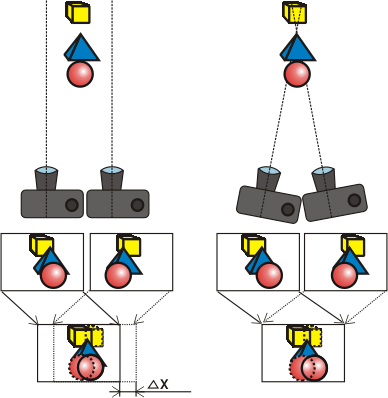3 Methods of taking stereo photos
All the methods described below are based on the principle of separate viewing - the left eye sees a left image of a stereo pair, while the right eye sees a right image. These methods differ in how the separation of stereo pair images is achieved. Thus, to create a stereo photo, you need a stereo pair. Usually, you get it by taking photos of the same object from two points that simulate the position of human eyes. The distance between the positions of taking left and right photos is called stereo base.
The size of the stereo base plays the key role in creation of a stereo photography. If you make stereo photos of a scene which is up to 3-5 meters away, it is quite enough to use the base of 65-70 mm, i.e. approximately the distance between human eyes. When the distance to the objects being shot increases, the stereo base should also be increased in order to get a good stereo effect. You can use the following formula to calculate the approximate stereo base:
B = 0.03*D,
where B is the stereo base and D is the distance to the closest object in the scene being shot.
The coefficient of 0.03 is used due to the angle of sight line convergence (approximately 1-2°) that provides optimal conditions for watching a stereo effect.
There are also more complicated models that calculating the stereo base taking into account the relative position of objects in the scene, camera parameters and being planned conditions of viewing finished stereo photo.
There are two methods of taking stereo photo: parallel and directional. When the parallel method is used, the direction of the optic axes of the camera lens does not change (Fig. 3-a), but when the directional method is used, the optic axes of the lens is turned so that it is always directed at the central object of the scene (Fig. 3-b). The directional method models the convergence of the human eyes.
The advantage of the parallel method is in its simplicity - you do not have to turn the camera. The disadvantage of this method is that you have to process the photos additionally i.e. compensational shift. Compensational shift means moving photos relatively to each other so that to get zero parallax (no doubling) for one of the objects in the composition (zero parallax object). This process models the convergence of eyes after a stereo pair is taken. When you view the stereo image, zero parallax objects will be perceived as located on the key plane; objects located closer to the photographer in real life will have negative parallax and seem as if they were in front of the zero parallax object;objects located in real life farther than the zero parallax object will have positive parallax and will be perceived as if they were in the background of the image. In Fig. 3, you can see a compensational shift (∆Х is the size of the compensational shift) where the stereo pair is aligned by the blue pyramid - this object has zero parallax.
After the shift is done, the horizontal size of the images get smaller - the stereo pair includes only those parts of the images that are aligned in the initial images. Actually, it is possible not to make the compensational shift. In this case, all objects on the scene will have negative parallax and seem as if they were in front of the plane the image is printed on. In this case, only "infinitely distant" objects will have zero parallax.
With the directional method, it is all vice versa, the process of taking photos becomes more complicated (you have to turn the camera), but the images you get - are already a stereo pair and if you take them without inaccuracies, you may need no additional processing.

a) b)
Fig. 3. Parallel and directional methods of taking stereo photos
The directional method sometimes allows you to get a stereo image that reproduces the natural perception more accurately. But the difficulty of this method is that the parallax of distant objects could be too large. It may reduce the comfort while viewing the stereo image. One more disadvantage of the directional method is a possibility of appearing different-angle affine distortions which may introduce some dissonance in the being viewed image. That is why this method is used to take photos under ad hoc conditions.
Due to its simplicity and the stability of its results, the parallel method is used more often. And computer processing makes executing of a compensational shift an easy task.